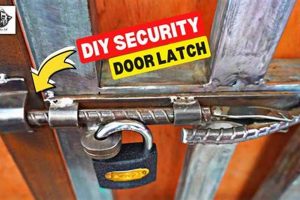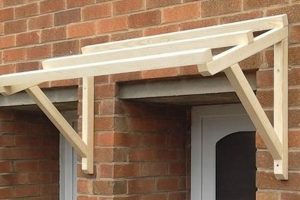Components enabling the construction and installation of sliding doors, frequently inspired by agricultural architecture, are acquired and assembled by the end-user. This approach contrasts with purchasing pre-fabricated systems. An example is a homeowner sourcing metal tracks, rollers, and brackets separately to create a unique interior door system.
Utilizing self-assembly methods allows for customization to precise specifications and often presents a cost-effective alternative to commercially available units. Historically, the repurposing of materials and the construction of functional elements were common practices. Contemporary adaptation of this approach provides individuals with greater control over design aesthetics and budget management while offering design flexibility.
The subsequent sections will address specific considerations for selecting appropriate materials, installation techniques, and essential safety precautions applicable to these projects. Furthermore, the article will explore common challenges encountered during the building process and propose practical solutions to address these issues.
Essential Guidance for Constructing a Sliding Door System
The following recommendations provide insights crucial for achieving a safe, functional, and aesthetically pleasing result when undertaking a self-assembly sliding door project.
Tip 1: Material Selection: Prioritize high-quality steel for tracks and rollers to ensure durability and smooth operation. Inferior materials may lead to premature wear or failure.
Tip 2: Precise Measurements: Accurately measure the door opening and account for track length, roller clearance, and any necessary overlapping. Incorrect measurements can result in misalignment and functional issues.
Tip 3: Weight Capacity Assessment: Determine the weight of the door and select hardware components with a sufficient load rating. Exceeding the weight limit can compromise safety and system integrity.
Tip 4: Secure Mounting: Anchor the track firmly to wall studs or a reinforced header board using appropriate fasteners. Insufficient anchoring can lead to track detachment and potential injury.
Tip 5: Roller Alignment: Ensure proper roller alignment with the track. Misalignment can cause friction, noise, and uneven wear.
Tip 6: Safety Stops: Install safety stops at both ends of the track to prevent the door from rolling off. These stops are essential for preventing accidents.
Tip 7: Smooth Operation: Apply lubricant to the rollers and track periodically to maintain smooth and quiet operation. Regular maintenance extends the lifespan of the system.
Adhering to these guidelines will contribute to the creation of a reliable and visually appealing sliding door system, enhancing both the functionality and aesthetic of the space.
The subsequent section will provide additional guidance on troubleshooting common issues that may arise during and after installation, ensuring the long-term performance of the system.
1. Material Durability
Material durability is a foundational element in determining the long-term performance and safety of self-assembled sliding door mechanisms. The selection of appropriate materials directly influences the system’s resistance to wear, corrosion, and structural fatigue. For example, opting for low-grade steel in the track and roller assembly may initially reduce costs; however, it can lead to premature bending, cracking, or corrosion, compromising the door’s smooth operation and potentially creating hazardous conditions. Conversely, utilizing high-carbon steel or stainless steel components enhances the system’s resistance to deformation under load and environmental degradation, extending its lifespan significantly.
The significance of material durability extends beyond mere longevity. The continuous operation of a sliding door system places stress on its components, particularly the rollers and track. Inadequate material strength can result in roller failure, leading to door jamming or detachment. Similarly, a track that lacks sufficient rigidity may deform over time, causing misalignment and increased friction. These issues not only diminish the system’s functionality but also necessitate frequent repairs or replacements, negating any initial cost savings. The material’s inherent resistance to environmental factors, such as moisture and temperature fluctuations, also plays a critical role, especially in outdoor or high-humidity environments.
In summary, prioritizing material durability is paramount for a successful and safe self-assembled sliding door installation. The selection of high-quality materials ensures long-term reliability, minimizes maintenance requirements, and mitigates potential hazards associated with component failure. While initial costs may be higher, the long-term benefits of enhanced durability far outweigh the risks associated with using inferior materials. The understanding of these material properties facilitates informed decision-making, leading to a more robust and dependable system.
2. Track Load Capacity
Track load capacity represents a critical specification for self-assembled sliding door systems. It defines the maximum weight the track assembly is engineered to support safely and effectively. Insufficient consideration of this parameter can lead to system failure, posing significant safety risks.
- Structural Integrity and Safety
The track’s structural integrity directly dictates its ability to bear the weight of the door. Exceeding the load capacity can cause the track to bend, warp, or detach from its mounting points, creating a collapse hazard. Accurate assessment and adherence to specified weight limits are thus paramount for ensuring user safety.
- Material Selection and Design
The materials used in track construction, such as steel gauge and alloy composition, directly influence load capacity. Similarly, the track’s design, including its profile and reinforcement features, impacts its ability to distribute weight effectively. Proper material selection and optimized design are essential for achieving the necessary load-bearing capabilities.
- Roller System Compatibility
The rollers must be rated to handle the weight of the door in conjunction with the track’s capacity. Mismatched roller and track ratings can result in premature wear and failure of either component. Harmonizing these two components ensures a balanced and reliable system.
- Installation and Support
Proper installation techniques, including secure mounting to wall studs or a reinforced header, are crucial for maximizing the track’s load-bearing potential. Inadequate support can compromise the track’s ability to distribute weight evenly, leading to localized stress and potential failure. Sturdy support structures and proper anchoring are vital.
The relationship between track load capacity and the overall functionality of self-assembled sliding door systems is undeniable. Comprehensive evaluation of door weight, selection of appropriately rated components, and meticulous installation practices contribute to a safe and durable system. Neglecting these considerations invites potential structural compromise and endangers users.
3. Roller System Precision
Roller system precision directly impacts the operational efficiency and longevity of self-assembled sliding door mechanisms. A precise roller system ensures smooth, quiet, and consistent movement, mitigating friction and wear on both the rollers and the track. Conversely, imprecise rollers, exhibiting play or dimensional inconsistencies, contribute to jerky motion, increased noise levels, and accelerated degradation of the system’s components. Consider, for instance, a sliding door utilizing rollers with poorly machined bearings; the resulting friction requires increased force to operate the door and generates audible noise. Such a scenario highlights the practical significance of roller system precision as a core element of functional and reliable operation.
The impact of roller system precision extends beyond immediate operational characteristics. Misaligned or poorly toleranced rollers induce uneven weight distribution across the track, leading to localized stress concentrations. These stress points can accelerate track deformation and increase the likelihood of roller failure. Proper roller precision minimizes vibration and ensures that the weight is distributed evenly along the track, thereby preserving the track’s integrity and enhancing the system’s overall lifespan. Furthermore, the quality and type of bearing used in the roller greatly affect its precision. Sealed bearings, for example, are less prone to contamination and maintain their precision over extended periods compared to unsealed alternatives. The choice of roller material, such as hardened steel or nylon, also contributes to precision and noise reduction during operation.
In summary, roller system precision is indispensable for achieving optimal performance in self-assembled sliding door systems. Accurate roller dimensions, high-quality bearings, and appropriate material selection are crucial for minimizing friction, ensuring smooth operation, and extending the system’s lifespan. Neglecting roller precision compromises the door’s functionality, increases maintenance demands, and potentially introduces safety concerns. Consequently, investing in high-precision roller systems represents a fundamental step toward creating a durable and reliable sliding door assembly.
4. Mounting Point Security
The robustness of the attachment method fundamentally determines the reliability and safety of a self-constructed sliding door system. Proper fixation to the supporting structure is essential to withstand the operational stresses and prevent catastrophic failure.
- Structural Integrity of the Wall
The wall or supporting structure must possess adequate strength to bear the weight of the door and hardware, along with any applied dynamic forces. Installation on weakened or non-load-bearing walls compromises the entire system, leading to potential collapse. Assessment of wall composition and reinforcement is crucial.
- Fastener Selection and Application
Appropriate fasteners, such as lag bolts or through bolts with backing plates, must be selected based on the wall material and the anticipated load. Improper fastener selection or insufficient tightening reduces the holding power, creating a risk of detachment. Adherence to manufacturer specifications and proper installation techniques are paramount.
- Header Board Reinforcement
When attaching the track to wall studs alone is insufficient, a reinforced header board spanning multiple studs provides a more robust mounting surface. The header board distributes the load across a wider area, reducing stress on individual studs. Proper header board installation significantly enhances mounting point security.
- Regular Inspection and Maintenance
Periodic inspection of mounting points is necessary to identify any signs of loosening, corrosion, or structural degradation. Addressing these issues promptly prevents further deterioration and potential failure. Proactive maintenance ensures the long-term stability of the system.
Mounting point security is not merely an isolated consideration but an integral element in the successful deployment of self-constructed sliding doors. The combination of a sound supporting structure, appropriate fasteners, and regular maintenance is essential for ensuring the long-term reliability and safety of the installation. Neglecting these aspects can result in hazardous conditions and costly repairs.
5. Operational Smoothness
A seamless sliding motion, free from friction and obstruction, defines operational smoothness in the context of self-assembled barn door systems. This characteristic directly influences user satisfaction, system longevity, and overall functionality, demanding careful attention during design and installation.
- Track Alignment and Leveling
Precise alignment and leveling of the track are fundamental to achieving smooth operation. Deviations from horizontal introduce uneven weight distribution, causing binding and jerky movement. For instance, a track that slopes slightly downward may cause the door to accelerate uncontrollably, while an upward slope requires excessive force to open. Accurate leveling ensures uniform weight distribution and minimizes friction.
- Roller Bearing Quality and Material
The quality and material composition of the roller bearings significantly impact the smoothness of the sliding action. High-quality bearings, such as sealed ball bearings, reduce friction and provide consistent performance over time. Conversely, low-grade bearings introduce increased friction and can degrade rapidly, resulting in noisy and uneven movement. Proper selection of roller bearings is crucial for long-term operational smoothness.
- Door Weight and Hardware Capacity
Matching the door’s weight to the hardware’s capacity is essential for smooth and safe operation. Overloading the system places excessive stress on the rollers and track, leading to increased friction and potential component failure. An adequately sized system, capable of supporting the door’s weight with a safety margin, ensures smooth and reliable performance. Calculations are vital to ensure load-bearing limits aren’t exceeded.
- Lubrication and Maintenance
Regular lubrication and maintenance of the rollers and track are necessary to preserve operational smoothness over time. Lubrication reduces friction and prevents corrosion, while periodic cleaning removes debris that can impede movement. Neglecting maintenance results in increased friction, noisy operation, and accelerated wear on the system’s components. A consistent maintenance schedule extends system life.
Operational smoothness is the culmination of meticulous design, careful component selection, and diligent maintenance. The elements discussed contribute directly to the seamless movement characteristic of a well-executed system. Attention to these details enhances the user experience, prolongs the life of the system, and ensures safe operation of self-assembled barn door hardware.
Frequently Asked Questions
The following section addresses common inquiries regarding the selection, installation, and maintenance of self-assembled sliding door systems.
Question 1: What constitutes essential hardware components for a functional sliding door system?
Essential components include a track of sufficient length, roller assemblies with appropriate weight ratings, mounting brackets for securing the track to the wall, door stops to prevent overtravel, and a floor guide to stabilize the door’s movement. Additional considerations involve fasteners appropriate for the wall construction and potentially a handle or pull for ease of operation.
Question 2: How is the appropriate track length determined for a given doorway?
Track length is generally calculated by doubling the width of the door opening. This allows the door to fully clear the opening when in the open position. Additional length may be required to accommodate overlapping doors or specific aesthetic preferences; however, doubling the doorway width serves as a reliable baseline.
Question 3: What safety precautions must be observed during installation?
Safety precautions include wearing appropriate personal protective equipment, such as safety glasses and gloves. Ensuring the wall structure can adequately support the door’s weight is critical. Precisely measuring and marking all mounting points, and securely fastening the track to structural studs are essential. Adherence to these precautions minimizes the risk of injury or system failure.
Question 4: What are the common indicators of a failing or improperly installed sliding door system?
Indicators of system failure include difficulty in sliding the door, excessive noise during operation, visible sagging or bending of the track, loose mounting hardware, and the door’s tendency to swing or wobble. Addressing these indicators promptly prevents further damage and potential hazards.
Question 5: How frequently should a self-assembled sliding door system undergo maintenance?
Routine maintenance should occur at least every six months, or more frequently in high-traffic areas. Maintenance involves inspecting and tightening all fasteners, lubricating the rollers, and cleaning the track to remove debris. Consistent maintenance prolongs the system’s lifespan and ensures smooth operation.
Question 6: What types of tools are essential for a typical sliding door hardware installation?
Essential tools include a measuring tape, level, stud finder, drill with appropriate drill bits, socket set or wrench, screwdriver, and potentially a saw for trimming the track or door. Having these tools readily available ensures efficient and accurate installation.
Adhering to the recommendations outlined in these frequently asked questions promotes a safe, functional, and aesthetically pleasing self-assembled sliding door installation.
The subsequent section will discuss advanced troubleshooting techniques for resolving persistent issues that may arise in self-assembled sliding door systems.
Concluding Remarks on Self-Assembled Sliding Door Systems
This exposition has detailed essential aspects of self-assembled sliding door systems, including material durability, load capacity, roller precision, mounting security, and operational smoothness. Successful implementation necessitates careful consideration of these factors, ensuring both functionality and safety. Adherence to recommended practices mitigates potential risks associated with component failure and improper installation.
The information presented serves as a foundation for informed decision-making. Diligent planning, precise execution, and consistent maintenance remain critical determinants in realizing a reliable and aesthetically pleasing sliding door installation. A commitment to these principles ensures the enduring performance of the self-assembled sliding door system, enhancing both the value and utility of the intended space.







